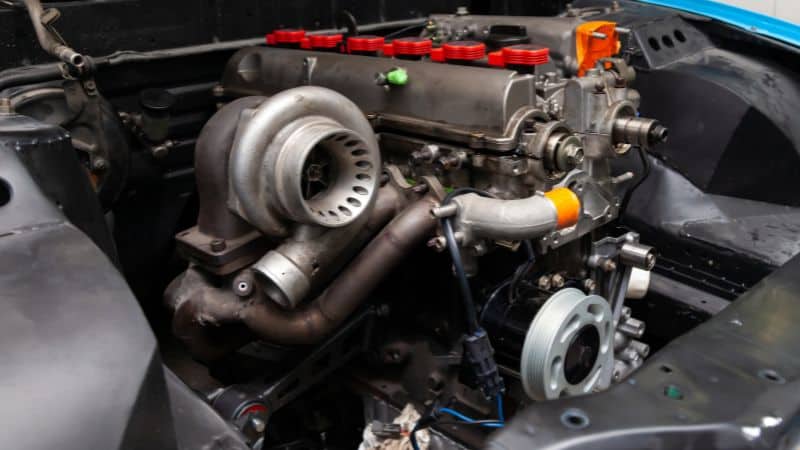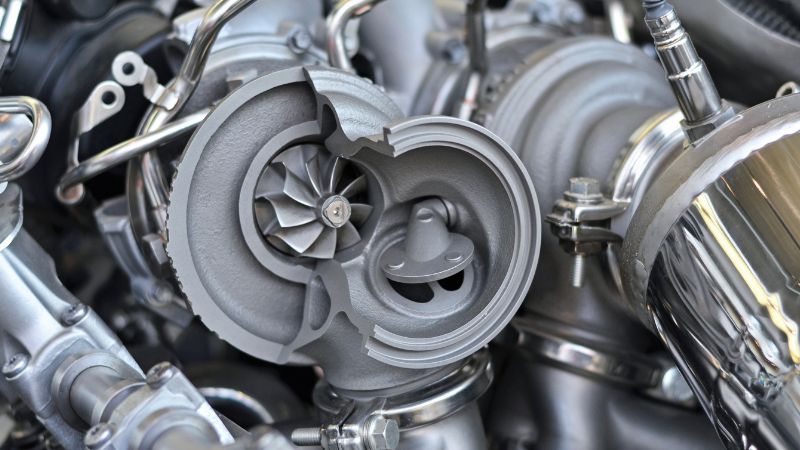A turbocharger is a device that helps in increasing the power output of an engine. As a car enthusiast, understanding the turbocharger working principle can help you get the most out of your vehicle. A turbocharger allows an engine to produce more power from a smaller displacement. In this comprehensive guide, you’ll learn the basics of how turbochargers work in a car and some tips to keep in mind to maximize their power and longevity.

What Is a Turbocharger and How Does It Work?
A turbocharger basically boosts the power and performance of an engine. It is made up of two main parts which are a turbine and a compressor. The turbine uses the energy of the exhaust gasses to spin the compressor. The compressor then forces more air into the engine’s combustion chambers. This results in a more powerful explosion and more power from each ignition.
Turbocharger Working Principles
The basic principle behind a turbocharger is that it allows more oxygen to be packed into the engine with each intake stroke. The more oxygen, the bigger the explosion and the more power can be generated. A turbocharger can increase an engine’s power output by up to 50% while maintaining fuel efficiency. Many performance vehicles and some eco-friendly vehicles use turbochargers to improve performance without significantly impacting fuel economy.
To properly utilize a turbocharger, there are a few factors to consider:
- Allow the turbocharger to cool after driving before shutting off the engine. This prevents overheating and extends the life of the turbocharger.
- Use high-quality synthetic oil and change it regularly. The oil lubricates and cools the turbocharger. Dirty or low oil can damage the turbo.
- Avoid aggressive driving like rapid accelerations which can put extra stress on the turbo. Performance driving in short bursts is fine but extended periods of aggressive driving can reduce turbo life.
- Listen for any strange noises from the turbocharger like squealing, grinding, or rattling sounds. Unusual noises can indicate a problem with the turbo that needs to be checked by a mechanic.
- Follow the vehicle manufacturer’s recommendations for turbocharger maintenance. Proper maintenance and care will keep your turbo running well for the life of your vehicle.
The Benefits of Turbocharged Engines
In this section, we’ll delve into the benefits of having turbocharged engines for your car.
Turbochargers offer several advantages over naturally aspirated engines. By compressing the air entering the engine, turbochargers allow more oxygen to be packed into the cylinders. This means more fuel can be added, which results in a more powerful combustion and higher power output.
Increased power and acceleration: Turbocharged engines can produce significantly higher power and greater acceleration compared to the same engine without a turbocharger. This makes a vehicle feel more responsive.
Improved fuel efficiency: Although turbochargers require engine power to operate, they allow an engine to produce the same power as a larger naturally aspirated engine but with better fuel efficiency. The turbocharger squeezes more power out of a smaller engine.
Higher torque: Turbochargers increase the amount of air and fuel in each cylinder, which results in higher torque, especially at lower engine speeds. This means greater pulling power and faster acceleration.
Engine downsizing: Turbochargers allow automakers to install smaller engines that produce equal or greater power than larger engines while improving fuel economy. A smaller turbocharged engine can replace a larger naturally aspirated engine.
Altitude compensation: Turbochargers help compensate for the loss of power at high altitudes where air is less dense. By compressing the air, a turbocharged engine can produce the same power at altitude as at sea level.
Longevity: Modern turbochargers do not reduce engine longevity when properly maintained. Turbocharged engines can last over 200,000 miles when cared for appropriately with routine oil changes and filter replacements.
Turbochargers have been popular for both gasoline and diesel-powered vehicles due to several benefits such as enhanced performance, improved efficiency, and engine downsizing. Turbochargers provide an advantageous solution for both automakers and drivers when properly installed and maintained.
How to Choose the Right Turbocharger
When selecting a turbocharger for your vehicle, some aspects should be considered to ensure proper performance and engine health. The most important considerations are:
- Engine displacement: The size of your engine, measured in liters, determines how much air it requires. Choose a turbocharger that can provide an appropriate air/fuel ratio for your specific engine displacement. Too small a turbo will not provide enough air, reducing performance gains, while too large a turbo can damage your engine by forcing too much air into the cylinders.
- Boost pressure: The amount of air pressure, measured in psi or bar, that the turbocharger provides to your engine. Higher boost pressure means more air is being forced into the cylinders, resulting in greater performance increases. However, a higher boost also means greater stress on your engine, so you must choose a boost level appropriate for your engine to avoid damage. In general, for a stock engine aim for 5-10 psi.
- Turbo size: The physical size of the turbocharger, depends on the amount of air it can compress. Larger turbos can provide higher boost levels but often have slower response times. A properly sized turbo should provide your desired boost level without significant lag in power delivery.
- Intercooler: An intercooler cools the compressed air before it enters your engine, allowing for a denser air charge and greater performance. Larger intercoolers provide better cooling but require more space. Choose an intercooler size to match your turbo and desired boost level.
- Bypass valve: A blow-off valve or bypass valve releases excess boost pressure when the throttle is closed to prevent damage to the turbo. For most applications a standard blow-off valve is sufficient, but high-performance vehicles may require an upgraded valve.

Installing and Maintaining Your Turbocharger
Installing and properly maintaining a turbocharger is essential to maximizing its performance and lifespan. As an add-on to your vehicle’s engine, the turbocharger requires attentive care and upkeep.
Choosing a Turbocharger
Select a turbocharger specifically designed for your vehicle’s make, model, and engine. An incompatible unit can damage your engine or perform poorly. Research various brands and models to determine the best option based on your needs and budget. For most casual drivers, a smaller turbocharger should suit your needs while minimizing costs.
Proper Installation
Have the turbocharger installed by a certified mechanic to ensure it is connected and fitted correctly? Inadequate installation can lead to oil or exhaust leaks, decreased performance, and premature failure of components. The mechanic will integrate the turbocharger with your vehicle’s pre-existing piping and make necessary adjustments to optimize performance.
Routine Maintenance
To maximize the longevity of your turbocharger, regular maintenance and service are required. Check and replace air filters frequently, inspect oil lines and coolant hoses for wear or damage, and change your engine oil as recommended in your owner’s manual. Neglecting routine maintenance can reduce performance and efficiency, and may void the turbocharger’s warranty.
Warning Signs
Be alert for any warning signs that your turbocharger may need service or replacement. Excessive noise such as whistling or grinding sounds, oil in the intercooler or tailpipe, loss of power, high exhaust temperature, and visible damage or rust on the unit indicate the turbocharger should be inspected by a mechanic as soon as possible. Early diagnosis and repair help prevent further damage to your engine and related components.
Following the proper installation, maintenance, and service guidelines for your vehicle’s turbocharger helps ensure peak performance, efficiency, and dependability. By remaining attentive to any warning signs of damage or reduced function, you can identify issues early and avoid costly repairs down the road. With routine care and upkeep, a turbocharger can provide many years of enhanced power and an improved driving experience.
The Best Turbocharged Cars on the Market
When it’s time to purchase a turbocharged vehicle, several factors should be considered regarding engine performance and reliability. Turbochargers compress the air entering the engine, allowing more air and fuel to be combusted, which results in greater horsepower. Anyway, the increased pressure and heat can reduce engine lifespan if the vehicle is not properly engineered. The following vehicles are renowned for their well-designed turbocharged engines that provide an ideal balance of power and dependability.
Subaru WRX STI
Subaru’s high-performance WRX STI is a prime example of an automobile with an exceptionally reliable turbocharged engine. Its 2.5-liter boxer four-cylinder engine uses a twin-scroll turbocharger to generate 310 horsepower and 290 pound-feet of torque. Subaru’s symmetrical all-wheel drive system provides outstanding handling and control. The WRX STI has a reputation for dependability and longevity, with properly maintained vehicles often exceeding 200,000 miles.
Porsche 911 Turbo
Porsche’s legendary 911 sports car reaches its highest performance level in the 911 Turbo models. Powered by a twin-turbocharged 3.8-liter six-cylinder engine that produces up to 640 horsepower, the 911 Turbo S accelerates from 0 to 60 mph in a mere 2.6 seconds. Despite such staggering performance, Porsche’s engineering expertise ensures notable reliability and a 50,000-mile engine warranty. The all-wheel-drive system provides superlative control for the immense power.
Audi RS7
Audi’s RS7 sedan demonstrates that a turbocharged performance vehicle can also serve as a practical daily driver. The 4.0-liter twin-turbo V8 engine generates 605 horsepower and 553 pound-feet of torque, rocketing the RS7 to 60 mph in 3.4 seconds. However, the luxurious cabin comfortably seats five adults, and the hatchback trunk facilitates loading cargo. Audi is renowned for building turbo engines that balance prodigious power with dependability. With routine service, the RS7’s engine and all-wheel drive system can provide years of trouble-free performance.
Frequently Asked Questions
These are some of the top common queries that people are concerned about car turbochargers. We’ve most of them covered here.
Question: What are the benefits of using a turbocharger?
Answer: Using a turbocharger in a car can provide several benefits, including improved engine efficiency, increased power output, enhanced acceleration, and potentially better fuel efficiency when the engine is downsized without sacrificing performance.
Question: Do all cars come with turbochargers?
Answer: No, not all cars come equipped with turbochargers. Turbochargers are commonly found in performance-oriented vehicles and some modern engines aiming for a balance between power and fuel efficiency. Many cars still use naturally aspirated engines that don’t rely on turbocharging.
Question: Are there any downsides to using a turbocharger?
Answer: While turbochargers can significantly boost engine performance, they can also lead to increased heat generation and potential stress on engine components. This might necessitate stronger engine components and additional cooling measures. Additionally, turbocharged engines might have a slight delay in throttle response due to the time it takes for the turbocharger to spool up.
Question: Will adding a turbocharger to my car increase its fuel consumption?
Answer: Yes, adding a turbocharger can potentially increase fuel consumption because it allows the engine to burn more fuel for higher power output. However, advancements in turbocharger technology and engine management systems aim to balance performance and efficiency.
Question: Do turbocharged engines require special maintenance?
Answer: Turbocharged engines may require more diligent maintenance due to increased stress on components. Regular oil changes are crucial, as turbochargers often require specific oil types and adequate lubrication to function properly. Cooling systems and intercoolers should also be well-maintained to manage the increased heat generated by the turbocharging process.
Final Thoughts
As you have learned, a turbocharger can significantly boost the power and performance of your vehicle. By forcing more air into the engine, it allows for more fuel to be burned, which translates into higher horsepower and torque. With some basic maintenance and care, a turbocharger can provide years of enhanced driving enjoyment. However, keep in mind that more power requires more responsibility. Exercise caution and remain aware of how the increased performance can impact handling, braking, and control. By understanding how a turbocharger works in a car and following some best practices, you’ll be able to get the most out of this performance upgrade while staying safe on the road.
Read Also: Do Turbochargers Increase Fuel Economy?


